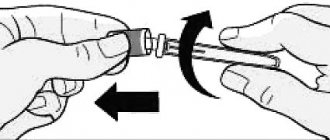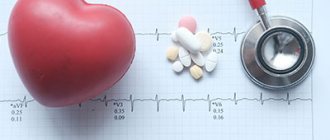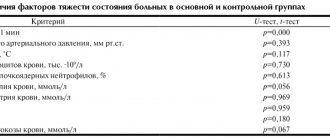Pharmacodynamics and pharmacokinetics
Pharmacodynamics
Marcaine is a long-acting local anesthetic, 4 times lidocaine Reversibly blocks the conduction of impulses along the nerve fiber. The mechanism of action is due to inhibition of the passage of sodium through cell membranes.
Has a hypotensive effect. With peripheral nerve blockade, the duration of anesthesia is 12 hours, with epidural anesthesia from 2 to 5 hours, with intercostal blockade - 7-13 hours. Available in two concentrations: 5 mg/ml and 2.5 mg/ml. The latter has less effect. Low doses have no pronounced effect and are used during childbirth, as well as after surgical interventions. There are several dosage forms.
Marcaine Spinal is a sterile aqueous solution of bupivacaine 5 mg/ml. The addition of sodium chloride makes it isotonic. Has a fast and powerful effect. The effect is longer lasting.
Marcaine Spinal Heavy - bupivacaine 5 mg/ml, no sodium chloride , but a dextrose , so the solution is hyperbaric. It spreads more intensively than the previous one, but due to its greater distribution it has a lower concentration at the injection site and a shorter effect.
Pharmacokinetics
The rate of absorption depends on the dose and route of administration. The maximum concentration is observed with intercostal blockades, and the minimum concentration is administered under the skin in the abdominal area. In the epidural space it is absorbed in 2 stages. With epidural administration, the half-life is 6 hours, with intravenous administration - 2.5 hours. In newborns, T1/2 is 7-8 hours longer than in adults. Highly protein bound. Completely metabolized in the body.
Note!
Description of the drug Marcain Spinal Heavy solution d/in. 5mg/ml amp. 4ml No. 5 on this page is a simplified author’s version of the apteka911 website, created on the basis of the instructions for use.
Before purchasing or using the drug, you should consult your doctor and read the manufacturer's original instructions (attached to each package of the drug). Information about the drug is provided for informational purposes only and should not be used as a guide to self-medication. Only a doctor can decide to prescribe the drug, as well as determine the dose and methods of its use.
Indications for use
Application of Marcaine
- infiltration anesthesia (after surgery) for trauma, arthroscopy ;
- during obstetrics, caesarean section ;
- intercostal blockade;
- blockade of large nerves;
- retrobulbar anesthesia.
Application of Marcaina Spinal
Spinal anesthesia for urological interventions, operations on the lower extremities or abdominal cavity.
Mode of application
"Marcain Spinal Heavy" should be used only by doctors with experience in regional anesthesia or administered under their supervision in small doses that make it possible to achieve a sufficient degree of anesthesia.
The doses of the drug recommended below should be considered as a guide to the use of the drug in adults; dose adjustments should be made individually for each patient.
The dose of the drug should be reduced for elderly patients and patients in the later stages of pregnancy.
Recommended dosage:
- urological surgical interventions - 1.5-3 ml (7.5-15 mg); time until effect occurs (approximately) - 5-8 minutes; duration of effect (approximately) - 2-3 hours;
- surgical interventions on the lower extremities, including surgical interventions on the hips - 2-4 ml (10-20 mg); time until effect occurs (approximately) - 5-8 minutes; duration of effect (approximately) - 2-3 hours;
- abdominal surgical interventions (including cesarean section) - 2-4 ml (10-20 mg); time until effect occurs (approximately) - 5-8 minutes; duration of effect (approximately) - 3/4-1 hour.
The recommended injection site is below L3.
To date, there is no clinical experience with doses higher than 20 mg.
Spinal injection of the drug is performed only after a clear identification of the subarachnoid space by lumbar puncture (until clear cerebrospinal fluid is obtained through a lumbar puncture needle or aspiration). In case of ineffective anesthesia, a new attempt to administer the drug should be made only at a different level with a smaller volume of anesthetic. One of the reasons for the insufficient effect may be improper distribution of the drug in the intrathecal space. In this case, a sufficient effect is achieved by changing the patient’s body position.
Newborns, infants and children weighing up to 40 kg
"Marcain Spinal Heavy" can be used in pediatric practice.
One difference between children and adults is the relatively high cerebrospinal fluid volume in infants and neonates, which requires a relatively larger dose/kg body weight to achieve the same level of blockade compared to adults.
Regional anesthesia procedures in children should be performed by qualified physicians who have adequate experience in administering regional anesthesia to children, as well as experience in performing anesthesia techniques.
The doses listed below should be considered as guidelines when using the drug in pediatrics. Cases of individual variability have been observed. Standard dosage recommendations should be taken into account when there are factors affecting individual block techniques and to meet individual patient requirements.
The lowest doses of the drug necessary to provide adequate anesthesia should be used.
Dosage recommendations for newborns, infants and children (body weight):
- < 5 kg - 0.40-0.50 mg/kg;
- from 5 to 15 kg - 0.30-0.40 mg/kg;
- from 15 to 40 kg - 0.25-0.30 mg/kg.
Contraindications
- increased sensitivity;
- childhood;
- arterial hypotension.
Marcain Spinal Heavy
- diseases of the central nervous system ( poliomyelitis , meningitis , brain tumor , bleeding);
- diseases of the spine in the active phase;
- spinal injury;
- disorders of the coagulation system;
- anemia;
- skin diseases at the puncture site;
- cardiogenic shock.
Both drugs are used with caution in diseases of the cardiovascular system , atrioventricular block , arrhythmia , in old age, multiple sclerosis and hemiplegia .
Similar drugs:
- Menovasin Topical solution
- Dimexid Solution for local and external use
- Dimexid Concentrate for external use
- Lidocaine Gel for external use
- Tantum Verde Solution for topical use
- Lidocaine Solution for injection
- Falimint Dragee
- Maraslavin Solution for topical use
- Heparin ointment Ointment for external use
- Septolete plus Lozenges
** The Drug Directory is intended for informational purposes only. For more complete information, please refer to the manufacturer's instructions. Do not self-medicate; Before starting to use the drug Marcain Spinal, you should consult a doctor. EUROLAB is not responsible for the consequences caused by the use of information posted on the portal. Any information on the site does not replace medical advice and cannot serve as a guarantee of the positive effect of the drug.
Are you interested in the drug Marcain Spinal? Do you want to know more detailed information or do you need a doctor's examination? Or do you need an inspection? You can make an appointment with a doctor - the Euro lab is always at your service! The best doctors will examine you, advise you, provide the necessary assistance and make a diagnosis. You can also call a doctor at home . Euro lab clinic is open for you around the clock.
** Attention! The information presented in this medication guide is intended for medical professionals and should not be used as a basis for self-medication. The description of the drug Marcain Spinal is provided for informational purposes only and is not intended for prescribing treatment without the participation of a doctor. Patients need to consult a specialist!
If you are interested in any other drugs and medications, their descriptions and instructions for use, information about the composition and form of release, indications for use and side effects, methods of use, prices and reviews of drugs, or you have any other questions and suggestions - write to us, we will definitely try to help you.
Side effects
- arterial hypotension;
- bradycardia;
- rhythm disturbances;
- heart failure;
- paresthesia , numbness of the tongue;
- dizziness , tinnitus;
- tremor , convulsions;
- double vision;
- peripheral nerve damage;
- anaphylactic shock;
- skin reactions;
- respiratory depression;
- urinary disorders;
- back pain, complete spinal block (for the drug Marcain Spinal Heavy ).
Side effects
Adverse reactions caused by the drug itself are difficult to distinguish from physiological effects associated with nerve blockade (eg, decreased blood pressure, bradycardia, temporary urinary retention), conditions caused directly by the procedure (eg, spinal hematoma) or indirectly by needle puncture (eg, meningitis). , epidural abscess), or conditions associated with cerebrospinal fluid leakage (for example, headache that develops after dural puncture).
Cardiac disorders: very often (> 1/10) - arterial hypotension, bradycardia.
From the gastrointestinal tract: very often (> 1/10) - nausea; often (> 1/100; < 1/10) - vomiting.
From the nervous system: often (> 1/100; < 1/10) - headache that develops after puncture of the dura mater.
From the kidneys and urinary system: often (> 1/100; < 1/10) - urinary retention, urinary incontinence.
Marcain, instructions for use (Method and dosage)
All types of anesthesia must be performed by a doctor, who determines the dose. The maximum dose is 2 mg per kg of weight, for adults usually 30 ml.
For infiltration anesthesia - 5-30 ml of solution.
For blockades of intercostal nerves - 2-3 ml per 1 nerve.
Blockade of large nerves (sacral or brachial plexus anesthesia) - 15-30 ml.
Caudal anesthesia during childbirth - 6-10 ml. During anesthesia, blood pressure .
Overdose
An overdose is manifested by the development of toxic effects on the part of the central nervous system and cardiovascular system . The same effects are observed with random intravascular administration. Manifestations of overdose are paresthesia , dizziness , numbness of the tongue, blurred vision and tinnitus. Subsequently, tremors and convulsions , an epileptic attack and loss of consciousness appear. The patient's condition improves when the drug is stopped. Reactions from the cardiovascular system develop later and are manifested by arterial hypotension , blockades and bradycardia .
Treatment consists of maintaining respiratory and circulatory function, providing oxygenation , and in severe cases, artificial ventilation. If seizures occur, sodium thiopental .
Special instructions for the use of the drug Marcain
Before starting treatment, it is necessary to test for individual sensitivity to the drug. Procedures using regional or local anesthetics (except for the most simple ones) should be performed in a room with technical resuscitation equipment. Intrathecal anesthesia should be performed by a physician with sufficient experience and knowledge. It is necessary to insert IV catheters before injecting local anesthetic when performing large blockades. There is evidence of cardiac arrest and death when bupivacaine is used for epidural anesthesia or peripheral nerve blocks. In some cases, resuscitation efforts were ineffective despite adequate therapy. Marcaine: When performing large peripheral nerve blocks, it is possible to use large amounts of the drug in highly vascularized areas, often near large vessels. In these cases, there is an increased risk of intravascular injection and/or systemic absorption, which can lead to high plasma concentrations of the drug. Like all local anesthetics, bupivacaine in high doses can cause acute toxic reactions from the central nervous system and cardiovascular systems. This is especially true for inadvertent intravascular administration. Some types of regional anesthesia may cause severe side effects:
- Epidural anesthesia can cause depression of the cardiovascular system, especially during hypovolemia. The drug should be used with caution in patients with impaired cardiovascular function.
- In isolated cases, retrobulbar injections can reach the intracranial subarachnoid space and cause temporary blindness, cardiovascular failure, apnea and seizures. Treatment must be started immediately.
- Retro- and peribulbar injections of local anesthetics may pose some risk of developing permanent ocular muscle dysfunction. The main causes are traumatic nerve damage and/or local toxic effects of the administered drug on muscles and nerves. In this regard, it is necessary to administer the minimum effective dose.
With accidental intravascular administration of the drug, even in low doses, cerebral symptoms may develop in the neck and head. When used in patients with 2nd or 3rd degree AV block, use caution since local anesthetics may reduce myocardial conductivity. Patients taking class III antiarrhythmic drugs (eg amiodarone) should be under close medical supervision. Consider the need for ECG monitoring in such patients, since the cardiac effects of bupivacaine and class III antiarrhythmic drugs may be additive. Elderly patients, with severe liver disease, severe renal impairment, and in serious condition require medical supervision. The risk of developing hypotension and bradycardia during epidural anesthesia is reduced with intravenous administration of a crystalloid or colloid solution. When blood pressure decreases, vasopressors are administered (for example, ephedrine hydrochloride (5–10 mg) intravenously, repeat the administration if necessary. During pregnancy and lactation. When performing a paracervical blockade, there is an increased risk of developing fetal tachycardia or bradycardia, fetal heart rate should be carefully monitored . Bipuvacaine passes into breast milk, however, the risk of a negative effect on the child is unlikely when using therapeutic doses of the drug. Children In pediatric practice, Marcaine is not used. Marcaine Spinal Heavy: before starting intrathecal anesthesia, it is necessary to ensure access for intravenous administration of drugs. Elderly patients age, with partial or complete cardiac conduction block, or severe hepatic or renal impairment require special attention, since regional anesthesia may be the optimal choice for surgical interventions in this group of patients.Patients taking class III antiarrhythmic drugs (amiodarone) should be monitored under close medical supervision with ECG control, since complications from the cardiovascular system may develop. With accidental intravascular administration of the drug, toxic effects on the cardiovascular system may develop. There is evidence of ventricular arrhythmia, ventricular fibrillation, sudden cardiac arrest and death in association with high systemic concentrations of bupivacaine. High systemic concentrations of the drug do not develop when the recommended doses for intrathecal anesthesia are observed. A rare but serious complication of spinal anesthesia is high or complete spinal block, which can lead to depression of the cardiovascular and respiratory systems. Suppression of the cardiovascular system is a consequence of widespread sympathetic blockade, which can cause severe arterial hypotension and bradycardia, including cardiac arrest. Respiratory depression may result from blockage of the innervation of the respiratory muscles, including the diaphragm. Elderly patients or women in late pregnancy are at risk for developing high or complete spinal block. The dose for these patients is reduced. When performing intrathecal anesthesia in patients with hypovolemia, the risk of sudden and severe arterial hypotension increases, regardless of the type of anesthetic administered. Hypotension following intrathecal blockade in adults is uncommon in children under 8 years of age. Neurological disorders are rarely noted. Symptoms: paresthesia, anesthesia, weakness of motor function and paralysis. Very rarely these phenomena are irreversible. Intrathecal anesthesia does not aggravate the course of diseases such as multiple sclerosis, hemiplegia, paraplegia and neuromuscular disorders, but this group of patients requires special attention. Before using an anesthetic, it is necessary to weigh the potential risk versus benefit for the patient from the procedure. During pregnancy and breastfeeding. Does not have a negative effect on the reproductive system. For women in late pregnancy, the dose of the drug is reduced. Bupivacaine passes into breast milk in very small quantities and there is no risk of adverse effects on the nursing infant. Children. Marcain Spinal Heavy can be used in pediatric practice. The ability to influence reaction speed when driving vehicles and working with other potentially dangerous mechanisms. Local anesthetics may have a slight effect on coordination of movements, temporarily impair motor functions and the speed of psychomotor reactions when driving.
Analogs
Level 4 ATX code matches:
Scandonest
Emla
Naropin
Versatis
Lidocaine
Ubistezin
Ultracaine D-S Forte
Ultracaine D-S
Ultracaine
Artikain
Bupivacaine , Bupicaine , Buvanestin , BlokkoS .
Reviews about Markain
Bupivacaine is a strong anesthetic that is 16 times stronger than novocaine . Anesthesia occurs more slowly when compared with lidocaine , but it is longer - the duration, depending on the dose and method of administration, can be 3-12 hours. The degree of muscle relaxation of this drug is also higher than that of lidocaine .
Spinal forms of Marcaine have proven to be effective and safe anesthetics. Their advantage is that they do not require combination with analgesics and additional prolongation. There is also no need to reduce the dose due to the risk of drug toxicity. These forms are used for all gynecological operations, caesarean sections , amputations, hernias, adenomectomies . Doctors, based on practical experience, believe that the hyperbaric form of the drug is better than the isobaric form, since it is more manageable. However, with spinal anesthesia, there are frequent cases of adverse reactions, which patients write about in their reviews.
- “... We did spinal anesthesia for caesarean section. The child was taken out, and I developed nausea, muscle tremors, and a feeling of lack of air.”
- “... They gave anesthesia with this drug during a caesarean section, but it didn’t work for me - there was no complete anesthesia, they added something else.”
- “...I got anesthesia, but it went away quickly, and when they began to suture the uterus, pain appeared. They added ketamine.”
Most often, when using the hyperbaric form of the drug, bradycardia begins in the postoperative period, and when using Marcain Spinal much earlier - in the operating room.
Overdose of the drug Marcain, symptoms and treatment
Marcaine: Systemic toxic effects from the central nervous system and the cardiovascular system develop due to high concentrations of local anesthetic in the blood due to accidental injection of the drug into the vascular bed, overdose or very rapid resorption of the drug from hypervascularized tissues. Accidental injections of local anesthetics into the vascular bed can cause immediate (onset time ranging from several seconds to several minutes) systemic toxic effects. In case of overdose, the systemic toxic effect takes longer to develop - 15–60 minutes after injection. On the part of the central nervous system, toxic effects develop gradually, with an increase in the severity of symptoms. The first symptoms usually include mild dizziness, perioral paresthesia, numbness of the tongue, hyperacusis, tinnitus and visual disturbances. Difficulty in articulation, jerky muscle movements, or tremors are serious symptoms that precede generalized seizures. These symptoms should not be interpreted as neurotic behavior. After this, loss of consciousness and a grand mal seizure may develop, lasting from several seconds to several minutes. During seizures, oxygen deficiency and hypercapnia quickly develop due to increased muscle activity and insufficient gas exchange in the lungs. In severe cases, apnea may develop. Acidosis enhances the toxic effects of local anesthetics. The healing process depends on the metabolism of the local anesthetic and its distribution beyond the central nervous system. This happens quickly, except in cases where a very large amount of the drug has been administered. From the cardiovascular system, the symptoms are more threatening. The first to develop, as a rule, are symptoms of intoxication from the central nervous system, which can be smoothed out with general anesthesia or deep sedation, with the use of benzodiazepines or barbiturates. Due to high systemic concentrations of local anesthetics, hypotension, bradycardia, and arrhythmia (even cardiac arrest) may develop. Cardiovascular toxic reactions are often associated with the inhibitory effect of the drug on the cardiac conduction system and myocardium, which leads to a decrease in cardiac output, hypotension, AV block, bradycardia and sometimes the development of ventricular arrhythmias (ventricular tachycardia, ventricular fibrillation and cardiac arrest). These conditions are often preceded by symptoms of severe intoxication from the central nervous system in the form of convulsions, however, in rare cases, cardiac arrest occurred without previous symptoms from the central nervous system. After a very rapid administration of an intravenous bolus injection of the drug, such a high concentration of bupivacaine in the coronary blood can be achieved that the effect on the circulatory system develops separately or before the onset of symptoms from the central nervous system. Given this mechanism, depression of myocardial function may appear as the first symptom of intoxication. Marcaine Spinal Heavy: When using bupivacaine in high doses, toxic reactions from the central nervous system and cardiovascular system may develop, especially when administered intravascularly. During spinal anesthesia, the drug is administered at a low dose (≤20% of the dose used for epidural anesthesia), so the risk of overdose is unlikely. However, when used simultaneously with other local anesthetics, systemic toxic reactions may develop due to their additive toxic effects. Treatment: administration of the drug must be stopped immediately. Adequate ventilation, oxygenation and circulation are maintained. In each case, it is necessary to provide oxygenation and, if necessary, mechanical ventilation. If after 15–20 s there is no spontaneous cessation of convulsions, the patient must be administered intravenous sodium thiopental at a dose of 1–3 mg/kg to improve ventilation or administered intravenous diazepam at a dose of 0.1 mg/kg (the drug is effective much slower). A prolonged period of seizures threatens the patient's breathing and oxygenation of the body. Injection of muscle relaxants (suxamethonium 1 mg/kg) helps ensure adequate ventilation of the patient's lungs and oxygenation; experienced personnel are required to perform tracheal intubation and mechanical ventilation. For hypotension/bradycardia - administration of vasopressors (ephedrine 5-10 mg IV, administration can be repeated after 2-3 minutes). In case of cardiac arrest, immediate cardiopulmonary resuscitation. Adequate oxygenation, respiration, and circulation must be maintained while acidosis is corrected. In case of cardiac arrest, prolonged resuscitation measures may be required. When treating systemic toxic reactions in children, doses appropriate to the age and body weight of the child are used.





